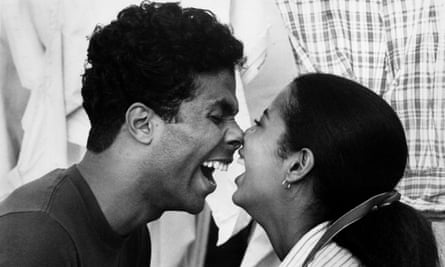Although her catalogue of recordings was not large, there were two songs that guaranteed Irene Cara a permanent place in the pop music hall of fame. In 1980 Cara, who has died unexpectedly aged 63, announced herself by topping the British singles chart with Fame, which also went to No 4 in the US.
It was the title song of Alan Parker’s eponymous film, documenting the struggles of students at New York’s High School of Performing Arts. Cara’s character, Coco Hernandez, was originally a dancer, but was rewritten to showcase her singing voice.

The song’s pumping, anthemic tune and ecstatic lyric made it the perfect embodiment of every wannabe star’s ambitions – “I’m gonna live forever, I’m gonna learn how to fly … I’m gonna make it to heaven, Light up the sky like a flame.” Its aspirational influence reached down the years through a string of talent shows such as American Idol, Britain’s Got Talent and The X Factor. Cara also became an inspiration for other Latin artists. The actor John Leguizamo tweeted: “She made me believe that if you were Latin you could make it! She fuelled my community.”
Both Fame and another single from the film soundtrack, Out Here on My Own (a Top 20 US hit), were nominated for Oscars, and since both were sung by Cara she achieved the rare feat of singing more than one song at an Academy Awards ceremony. Fame took the best original song statuette on the night. But her best was yet to come. Oscar night, 1984, found Cara back in the spotlight, basking in the glow of her huge success with Flashdance … What a Feeling.
It was the title song from Adrian Lyne’s film Flashdance, and it occupied the No 1 slot on Billboard’s Hot 100 for six weeks while topping numerous other charts around the world. This time Cara was one of the songwriters, along with Giorgio Moroder and Keith Forsey, and shared in the triumph when it won the Oscar for best original song.
It also picked up a Golden Globe and two Grammys. The film was the story of an ambitious dancer trying to win a place at an elite dance conservatory, and Cara wanted the lyric to show how the character is “in control of her body when she dances and how she can be in control of her life”. She added: “I did sense that I had something special with this song.”
Born in the Bronx, New York, Irene was the youngest of five children of her Cuban-American mother, Louise, a cinema usher, and her Puerto Rican father, Gaspar Escalera, a factory worker and former musician. She studied the piano, dance and acting from an early age, and made her Broadway debut, at the age of nine, in the musical Maggie Flynn.
She attended the Professional Children’s School in Manhattan, an apt training ground for her future role in Fame, and in her teens became a TV regular, appearing in PBS’s The Electric Company and the classic cop show Kojak. In 1975 came her first film appearance, as Angela in Aaron Loves Angela. She also played the title role of Sparkle Williams in Sparkle (1976), a musical drama loosely based on the career of the Supremes.

In 1979 she was cast in the powerful TV mini-series Roots: The Next Generations, based on the later chapters of Alex Haley’s novel Roots: The Saga of an American Family. The following year brought further acclaim as she joined a stellar cast in the mini-series Guyana Tragedy: The Story of Jim Jones, about Jones’s Peoples Temple cult and the mass suicide at Jonestown in 1978.
As a recording artist, she released her first album, Anyone Can See, in 1982, and it reached 76 on the US album chart. Surprisingly, the follow-up, What A Feelin’ (1983), was also only moderately successful despite the inclusion of the Flashdance song, though it produced the Top 20 single Why Me? and a Top 10 hit with Breakdance.
Cara’s recording career was blighted by a protracted legal wrangle with her record label, Network. “It took eight years and it cost me my future as a recording artist, because no other label would sign me,” she said. She released a third album, Carasmatic, on the Elektra label in 1987, but despite a formidable cast of supporting musicians it failed to chart. Cara protested that the label had failed to promote the album. In 1993 she won a legal ruling awarding her unpaid royalties.

In Joel Schumacher’s film comedy D.C. Cab (1983), about a group of Washington taxi drivers, she played herself, and her soundtrack contribution The Dream (Hold on to Your Dream) reached the US Top 40. She co-starred in For Us the Living: The Medgar Evers Story (also 1983), depicting the life of the assassinated civil rights activist.
In City Heat (1984) she appeared opposite Clint Eastwood and Burt Reynolds, and sang Embraceable You and Get Happy, and the following year she partnered Tatum O’Neal in Certain Fury. Further film credits included Busted Up (1986) and Caged in Paradiso (1989), though her subsequent film efforts involved mainly voice-only work, for instance voicing Snow White in Happily Ever After (1989) and Beauty in Beauty and the Beast (1992).
In the 2000s, Cara, who had homes in Largo, Florida and Santa Fe, New Mexico, opted for semi-retirement, though she mentored the all-female group Hot Caramel and released the album Irene Cara Presents Hot Caramel in 2011.
“I have a beautiful home by the beach and life is good,” she said. “I make more money not working than I do by working.”
In 1986 she married the stuntman and film director Conrad Palmisano; they divorced in 1991.
Stay connected with us on social media platform for instant update click here to join our Twitter, & Facebook
We are now on Telegram. Click here to join our channel (@TechiUpdate) and stay updated with the latest Technology headlines.
For all the latest Music News Click Here
